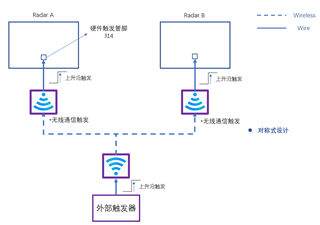Other Parts Discussed in Thread: AWR1642BOOST, AWR1642
Hi team,
There are two AWR1642BOOST (a millimeter wave radar development board), and the synchronization requirement is to align the clock start time of the two boards that transmit the antenna pulses.
Wired synchronization has been achieved, which triggers both development boards simultaneously with an external trigger source triggered by rising-edge triggering. However, wireless synchronization is now required, as shown in the following figure, the customer would like to know is there any device can function as a module in the purple box in the figure:

One of the e2e engineer recommends the following: I am not an expert in wireless communication domain, but you could look at using WiFi devices like CC3220 That could be used to sync. The two wifi devices connected to the AWR1642 devices could be synched over air and hey could Toggle a GPIO to HW trigger the AWr1642 frames
Since the customer is not familiar with TI's WiFi family development board before. There are two questions:
1. Is it complicated to use the CC3220 to configure the time synchronization shown in the figure?
2. What is the highest time synchronization accuracy possible with the CC3220?
Could you help check this case? Thanks.
Best Regards,
Cherry

